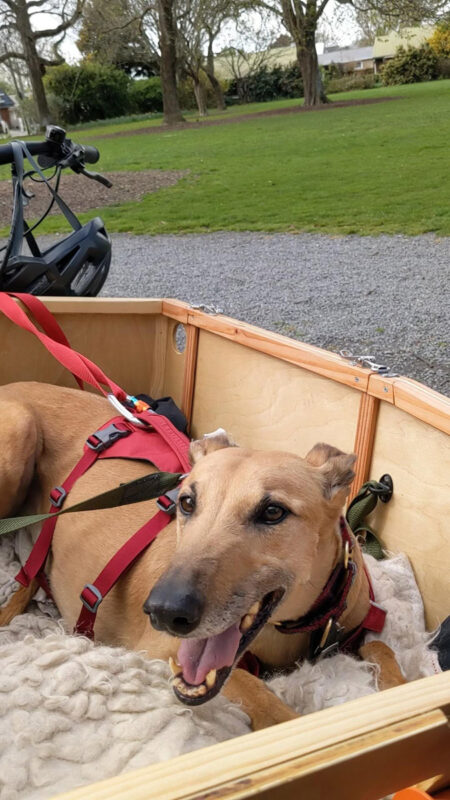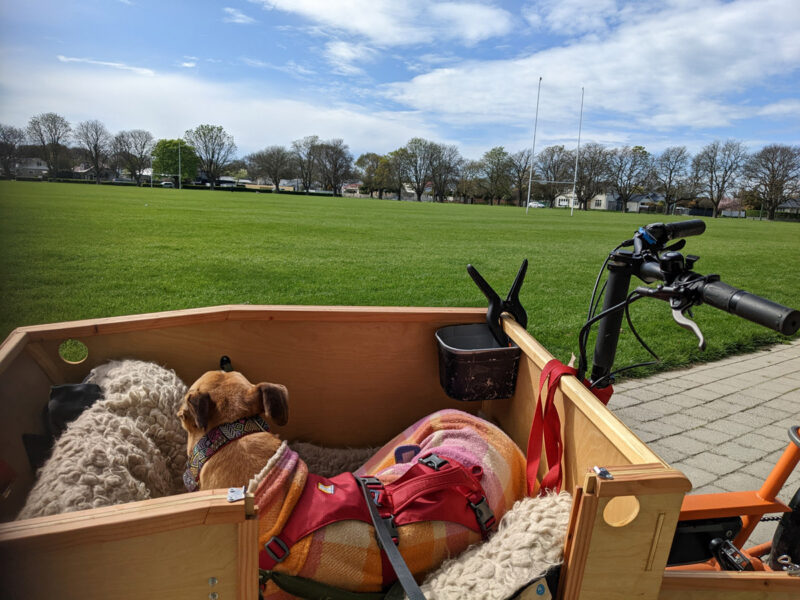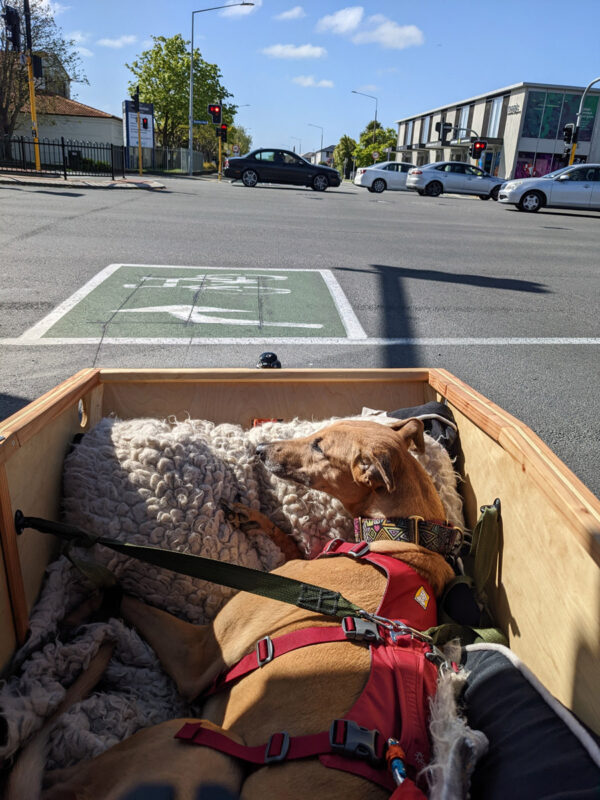 No, we’re not talking about some clever circus trick; here is a very practical guest post from Douglas Horrell about the interesting question of how to bring your favourite furry friend along for a ride on your bike…
No, we’re not talking about some clever circus trick; here is a very practical guest post from Douglas Horrell about the interesting question of how to bring your favourite furry friend along for a ride on your bike…
This is an old dogs / new tricks post, and hopefully also a how-to guide for anyone who’d like to train their dog to travel by bike. I’m not an expert but I’d like to pass on some of the tips we learnt along the way so others can give it a try.
Why bike with your dog? It’s fun! And obviously, when you leave the house they want to tag along. It’s also a great way to get to out-of-the-way parks and places, and it can be a useful mobility tool as your dog gets too old for long walks. I got inspiration and information from local people in Ōtautahi/Christchurch who bike with their dogs, and also from #cargobikedog and @dogsbybike on Instagram, r/cargobike on Reddit, Facebook groups like Cargo Bike Dogs, and there are some good YouTube videos too.
Basics
Got a small dog? No problem! The training techniques will be similar but the load problem is decreased. A basket, a backpack or a pannier bag may be all you need to travel comfortably on a regular bike. But what if your dog is bigger? Meet Luna – she’s a 9y/o greyhound who weighs 30kg and is quite tall.

Research suggested that our options were either a bike trailer or a bakfiets (cargo or box bike). As I’d been looking for something to carry bigger loads, an e-cargo bike was a great choice, and doubles as my utility vehicle for work. My bike was made locally by the talented Pete Thornton at Cargo Bike World, who dubbed it the “Greyhound Bus”.
I chose to make my own removable box, incorporating a side door to make it easier for Luna to step in – important as her arthritis worsens and so I don’t have to lift her. Some people train their dog to jump straight into the box, but this is probably easier with smaller and medium dogs. In addition to a comfortable bed, the box has three safety straps that clip onto her harness (though now one suffices).
How much space does a dog need? Ideally the box or trailer should be a snug fit for the dog by themselves, or with children or extra cargo. Most dogs will happily sit on their haunches but greyhounds just don’t. I made our box oversized so Luna could lie down. This is also good because the lower a large dog’s centre of gravity the easier it is to balance the bike, though balance isn’t as big a problem for trailers and 3-wheeled box bikes.

Training
It depends on your dog how fast this should go. If they are outgoing and fearless then you may have the basics sorted in a day. We went slower over a few weeks knowing that Luna reacts to strange noises and unsteady surfaces, and I wanted to avoid bad experiences with the bike. Before we started on the road she was first taught to find treats in the standalone box. She was rewarded for getting in it, then gradually built up to wearing a harness and being led into the box and clipped in with the door in place, followed by lots of treats and praise. The next step was the same but with the box on the stationary bike, propped up so it didn’t tilt or move.
Finally, Luna’s first day on wheels! On the first day, we walked her to a quiet cul-de-sac, got her on the bike and pushed it at a walking pace, while my wife Jess held her harness to steady her. This wasn’t popular! She stood and shivered the whole time and refused treats. We’d anticipated that moving would be a bit stressful (and had sprayed her harness beforehand with Adaptil calm travel spray). After 3-4 minutes she’d had enough and tried to jump out. We stopped there as short, positive training sessions are best.
Back to pushing her on the bike the next day. She wasn’t keen to start with, but this time realised it was much less frightening if she lay down on the comfy bed in the box. This time I pushed her to the nearby park and we got out and went for a walk – making trips fun (and not just about training) is a good idea.
Day 3 began with being pushed, then gently riding on the nearby separated cycleway and round a cul-de-sac. She was clearly relaxing so I ventured a little further, visiting two local parks and getting off for walks at each. I was careful to stay on slow streets and protected cycleways, and away from big intersections and car traffic.

Over the next few weeks we slowly built up our journeys, travelling further, faster, and using busier roads. A process of gradual desensitisation is important for building up your dog’s tolerance of bumps, noise and traffic to a point where they won’t try and leap out of the box when a large, loud vehicle passes you.
The best part of all now is seeing Luna having a great time on the bike. She travels all over town, lazily sniffing the breeze and dozing contentedly in her sofa-on-wheels. Pedestrians and cyclists often stop to talk to us so she’s learned that being on the bike means getting lots of attention and pats. And it’s fun spontaneously going places without needing to go home for the dog. Getting from A to B with your dog in NZ is very associated with using a car but it’s great to discover that bikes are a perfectly viable option too. I’d encourage anyone to give cycling with their dog a go.
Do you have a dog that you have biked with?


What a great guest post, thank you for sharing your experience on getting you dog used to riding in the front of your cargo bike.
Thanks for the kind comment. I’m very happy to share info, as when we started looking around there wasn’t much out there about biking with dogs, especially larger ones.
Great write up, I have one of Pete’s fantastic bikes and also carry our border collie in the front box plus kids! It pays to ease them into it, once they have feel they love it knowing the adventures they are about to go on!
Thanks for sharing Douglas!
I’m about to start experimenting with this whole dog sitting. Great tips to start small, keep it fun and build up. Shout out to Pete for recommending it